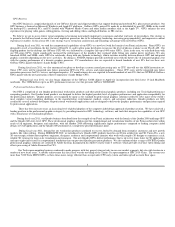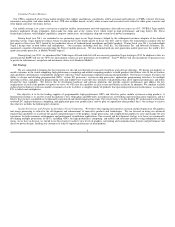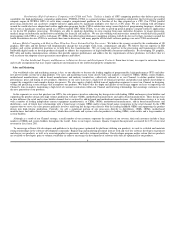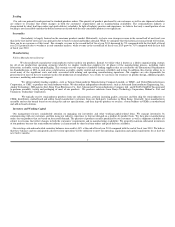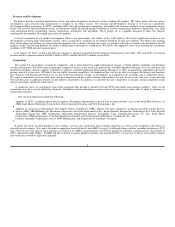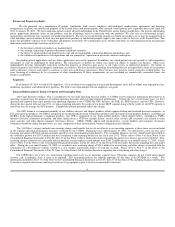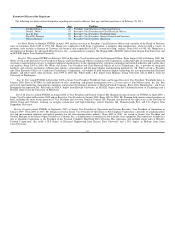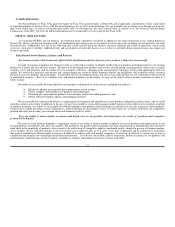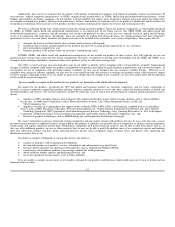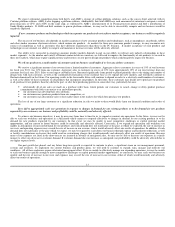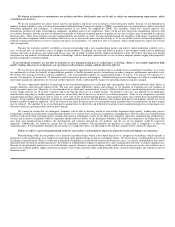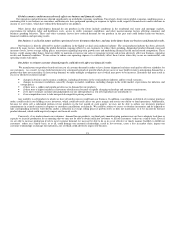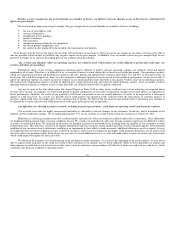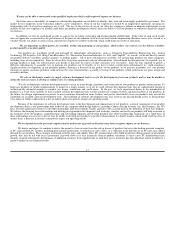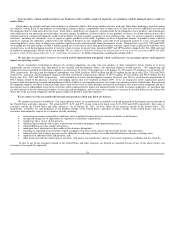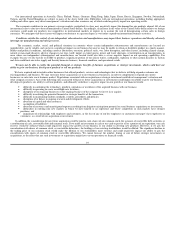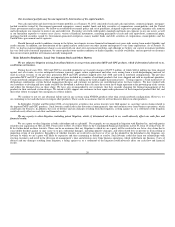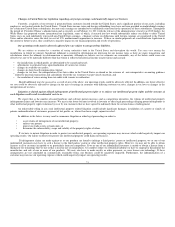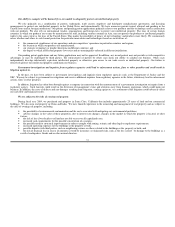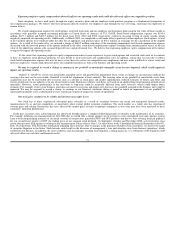NVIDIA 2011 Annual Report Download - page 15
Download and view the complete annual report
Please find page 15 of the 2011 NVIDIA annual report below. You can navigate through the pages in the report by either clicking on the pages listed below, or by using the keyword search tool below to find specific information within the annual report.
We expect substantial competition from both Intel’s and AMD’s strategy of selling platform solutions, such as the success Intel achieved with its
Centrino platform solution. AMD is also shipping a platform solution. Additionally, Intel and AMD have each announced its intention to integrate a central
processing unit, or CPU, and a GPU on the same chip, as evidenced by AMD’s announcement of its Fusion processor project and Intel’s introduction of
Sandy Bridge products. If AMD and Intel continue to pursue platform solutions, we may not be able to successfully compete and our business would be
negatively impacted.
If new consumer products and technologies which incorporate our products do not achieve market acceptance, our business could be negatively
impacted.
The success of our business also depends on market acceptance of new consumer products and technologies, such as smartphones, smartbooks, tablets
and other similar consumer electronics devices, which contain our products. As markets for these new consumer products emerge, we may encounter new
sources of competition as well as customers who have different requirements than those in the PC business. If market acceptance of such products and
technologies is not attained, our ability to compete and maintain or increase revenues will be adversely affected.
Our ability to be successful in emerging consumer product markets depends in part on our ability to cultivate new industry relationships in these
market segments. As the number and variety of Internet-connected devices increase, we will need to improve the functionality of our products to succeed in
these new markets, which may require significant time and resources on our part to design our products which could negatively impact our business.
We sell our products to a small number of customers and our business could suffer if we lose any of these customers.
We receive a significant amount of our revenue from a limited number of customers. Aggregate sales to customers in excess of 10% of total revenue
for fiscal year 2011, was 12% from one customer. Aggregate sales to customers in excess of 10% were approximately 12% of our total revenue from one
customer for fiscal year 2010. Sales to our largest customers have fluctuated significantly from period to period primarily due to the timing and number of
design wins with each customer, as well as the continued diversification of our customer base as we expand into new markets, and will likely continue to
fluctuate dramatically in the future. Our operating results in the foreseeable future will continue to depend on sales to a relatively small number of customers,
as well as the ability of these customers to sell products that incorporate our products. In the future, these customers may decide not to purchase our products
at all, purchase fewer products than they did in the past, or alter their purchasing patterns in some other way, particularly because:
• substantially all of our sales are made on a purchase order basis, which permits our customers to cancel, change or delay product purchase
commitments with little or no notice to us and without penalty;
• our customers may develop their own solutions;
• our customers may purchase products from our competitors; or
• our customers may discontinue sales or lose market share in the markets for which they purchase our products.
The loss of any of our large customers or a significant reduction in sales we make to them would likely harm our financial condition and results of
operations.
If we fail to appropriately scale our operations in response to changes in demand for our existing products or to the demand for new products
requested by our customers, our business and profitability could be materially and adversely affected.
To achieve our business objectives, it may be necessary from time to time for us to expand or contract our operations. In the future, we may not be
able to scale our workforce and operations in a sufficiently timely manner to respond effectively to changes in demand for our existing products or to the
demand for new products requested by our customers. In that event, we may be unable to meet competitive challenges or exploit potential market
opportunities, and our current or future business could be materially and adversely affected. Conversely, if we expand our operations and workforce too
rapidly in anticipation of increased demand for our products, and such demand does not materialize at the pace at which we expected, the rate of increase in
our costs and operating expenses may exceed the rate of increase in our revenue, which would adversely affect our results of operations. In addition, if such
demand does not materialize at the pace which we expect, we may be required to scale down our business through expense and headcount reductions as well
as facility consolidations or closures that could result in restructuring charges that would materially and adversely affect our results of operations. Because
many of our expenses are fixed in the short-term or are incurred in advance of anticipated sales, we may not be able to decrease our expenses in a timely
manner to offset any decrease in customer demand. If customer demand does not increase as anticipated, our profitability could be adversely affected due to
our higher expense levels.
Our past growth has placed, and any future long-term growth is expected to continue to place, a significant strain on our management personnel,
systems and resources. To implement our current business and product plans, we will need to continue to expand, train, manage and motivate our
workforce. All of these endeavors require substantial management effort. If we are unable to effectively manage our expanding operations, we may be unable
to scale our business quickly enough to meet competitive challenges or exploit potential market opportunities, or conversely, we may scale our business too
quickly and the rate of increase in our costs and expenses may exceed the rate of increase in our revenue, either of which would materially and adversely
affect our results of operations.
13



